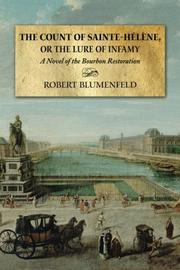

The Count of Sainte-Hélène, or The Lure of Infamy
A Novel of the Bourbon Restoration
by Robert Blumenfeld
In Blumenfeld’s (Teach Yourself Accents: Europe, 2014, etc.) historical novel, duplicity reigns in Bourbon Restoration–era France.
As the novel opens, the “charming, if slightly obsequious” Count of Sainte-Hélène, along with King Louis XVIII and other French elites, is watching a play about the abdication of Mary, Queen of Scots. The upheaval depicted onstage reflects the novel’s 1816 setting, in which the Bourbons have been newly restored to the throne, one year after Napoleon’s defeat at Waterloo and 27 years after the start of the French Revolution. The era’s social confusion has allowed the class structure to become more fluid than usual: Vidocq, the police detective, has his own history of criminality and prison escapes, and the aristocrats who frequent the king’s court don’t always have the highborn lineages they proclaim. When robbers strike the homes of some of those aristocrats, as well as the government’s Central Records Office, Vidocq is tasked with uncovering the mastermind, who appears to have an insider’s knowledge of the burgled homes. The disguise-loving Vidocq well knows, however, that appearances can be deceiving. The first scene’s setting is apt, as Blumenfeld’s novel is highly theatrical, adding fine flourishes to both its historical figures and its fictional characters. The king’s obsessive gluttony, a duchess’s strangely insightful malapropisms and a baron’s clueless seduction tactics (“Kiss me, my stuffed cabbage!”) would make any comedic actor exuberant. The novel’s third act centers on a series of trials, and the overall tension starts to dissipate as those trials progress; nonetheless, they would still make for vivid scenes on a lavishly designed stage. The author can sometimes be a bit showily clever and overly explanatory, as when he describes a man “whose moustache and beard hid not only his extreme probity, for he was the soul of honesty, but also his ruthless cunning, for he was the epitome of rapacity.” But his style is also precise, classic and witty, and an admirably faithful homage to 19th century French greats.
A lively ode to the classics, and to the twin delights of mischief and mayhem.